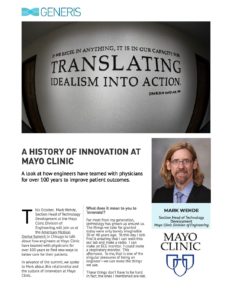This October, Mark Wehde, Section Head of Technology Development at the Mayo Clinic Division of Engineering, will join us at the American Medical Device Summit in Chicago to talk about how engineers at Mayo Clinic have teamed with physicians for over 100 years to find new ways to better care for their patients.
In advance of the summit, we spoke to Mark Wehde about this relationship and the culture of innovation at Mayo Clinic.
What does it mean to you to ‘innovate’?
For most of my generation, technology has grown up around us. The things we take for granted today were only barely imaginable 30 or 40 years ago. To this day I still find it amazing that I can walk into our lab and make a radio. I can make an ECG monitor. I could make a respiratory monitor. This afternoon. To me, that is one of the singular pleasures of being an engineer – we can make the things we use.
These things don’t have to be hard. In fact, the ones I mentioned are not. But the knowledge to make them is hard-earned. The classes are hard, and that and the dedication and hard work involved in the pursuit of knowledge are the price of entry. This creates a barrier to entry and only when you have passed through it by mastering the fundamentals can you then truly begin to innovate. Innovation is a subset of invention. An invention may be new, it may be novel, but this doesn’t imply usefulness. An innovation must be useful; it must create a change. In a sense, invention is the purview of the scientist and innovation the aim of the engineer.
Innovation is a buzz-word across our industry now, but I will insist that there is no innovation without creating change. An idea is not an innovation. To innovate, you must have the ability to develop your ideas into a useful commodity. Many healthcare organizations have become very good at coming up with ideas. What many haven’t solved well is how to move them into practice.
I am, perhaps understandably, biased towards the creation of new devices. From my very first day at Mayo Clinic, that is what I’ve done. In my early career at Mayo, I was making good use of the advent of personal computers and the relatively recent introduction of microprocessors. I grew up in a time when electronics and computers were first being integrated in ways that allowed for new capabilities. I could shut my door for days and delve into the deepest depths of technology, learning and discovering things that very few other people knew.
It’s exciting to be on the front end of a massively disruptive technology. Each generation seems to have its opportunity and I believe there is a special joy in trying to do something that no one else has ever done.
Additional Questions:
- What are the values of Mayo Clinic and how has the organization changed over time?
- How has the Division of Engineering changed over time?
- What have you learned as you have developed as a leader within the Division of Engineering?
- How do you find the motivation to continue to push for advancements and bridge the gap between hospitals and medical device manufacturers?
Click through to read the entire interview with Mark Wehde, Section Head of Technology Development at the Mayo Clinic Division of Engineering.

%20(1).png?width=773&height=112&name=Generis%20Logo%20full%20Colour%20(Large)%20(1).png)



